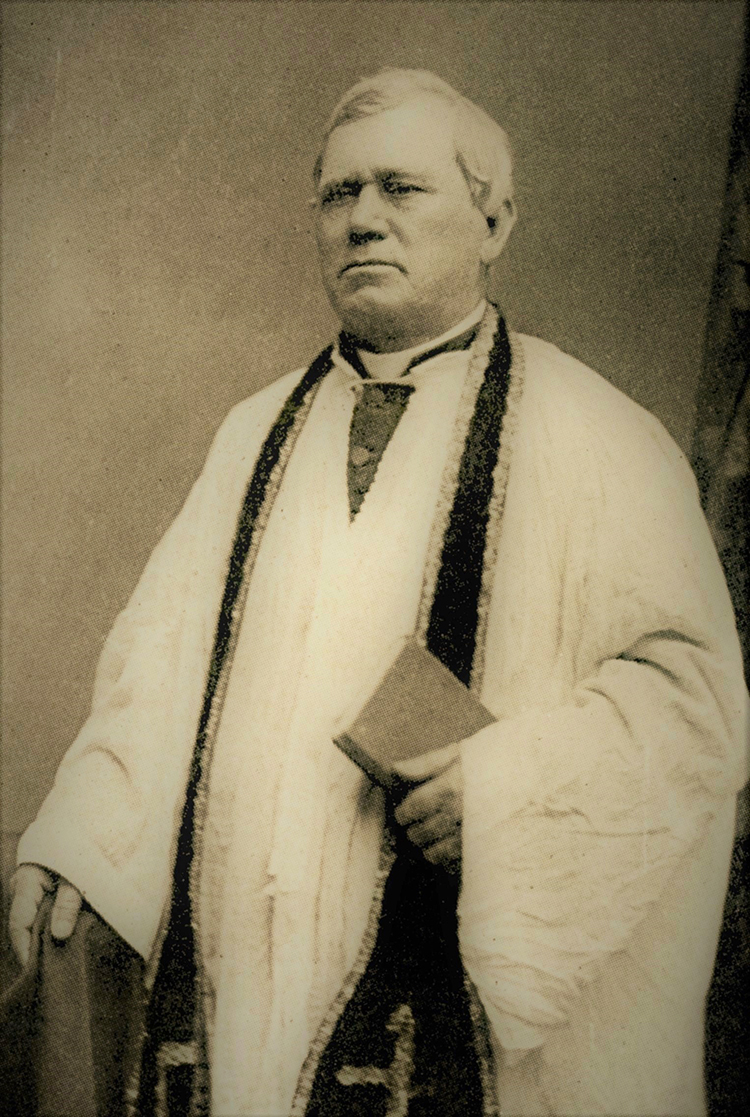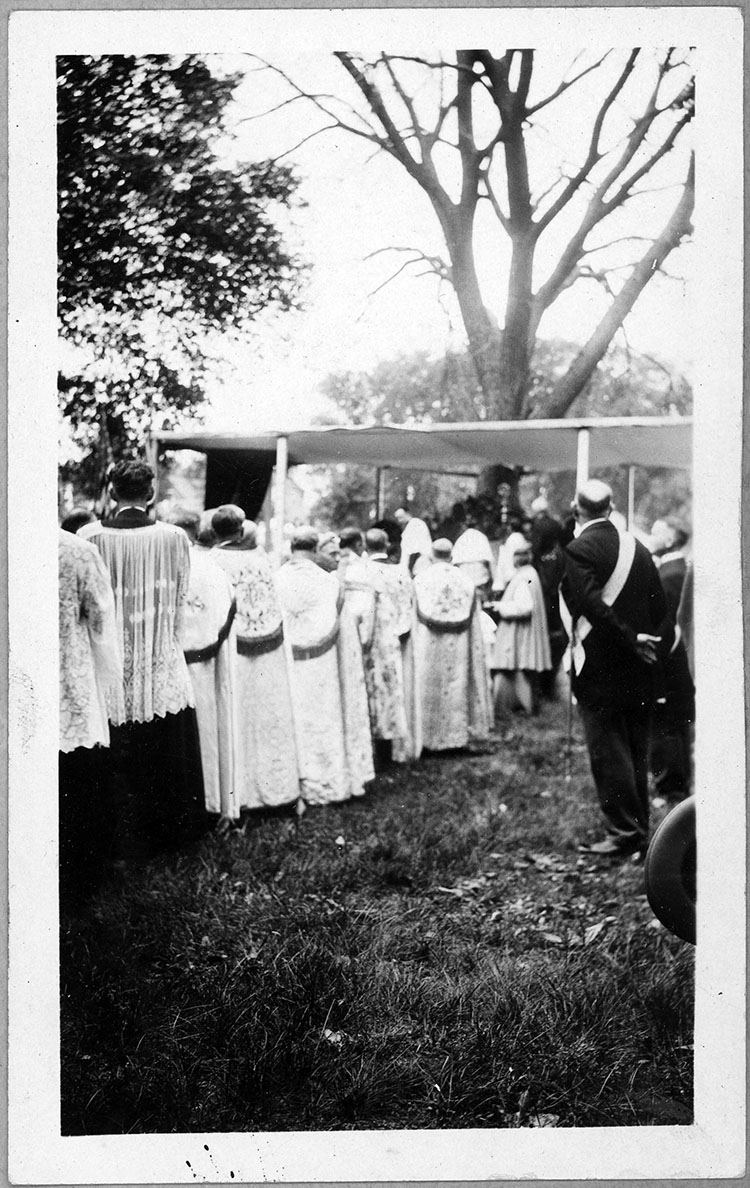Home movies are treasured time capsules documenting birthdays, weddings and other cherished memories. Reader Barbara Walsh acknowledges her fortune in having a collection of 8mm films of her family from the 1930s through the 1950s.
One particular film in her collection sparked her curiosity — a one minute and eight second clip titled:
CEMETERY DAY
ST. MARY’S
OCT. 8 / 38
The footage shows a long procession of clergy making its way past onlookers dressed in church attire. After a cut-away, the camera pans across the cemetery to show a crowd of people standing among ornate headstones and monuments watching the proceedings from afar.
Ancestors on both sides of Walsh’s family tree are buried at Mount St. Mary’s. Visiting the cemetery and placing wreaths on the gravesites of loved ones was an annual tradition of her maternal grandparents, Arthur and Marguerite Nester, and their children. It was her grandfather, an avid photographer, who filmed the 1938 Cemetery Day event.

Nester family headstone at Mount St. Mary’s Cemetery. BARBARA WALSH
Walsh reached out to What’s Your KCQ?, a joint project of the Kansas City Public Library and The Kansas City Star, to research the significance of Cemetery Day at Mount St. Mary’s, and whether it was celebrated citywide.
Burial Grounds of Kansas City Pioneers
Mount St. Mary’s was established in 1877 at 22nd Street and Cleveland Avenue and is one of four cemeteries operated by Catholic Cemeteries of Kansas City-St. Joseph. It’s the final resting place of more than 45,000 Catholics.
The cemetery has ties to Kansas City’s first Catholic church, St. Francis Regis, erected in 1835 near what is today 11th and Pennsylvania streets, and Father Bernard Donnelly, a pioneering priest who became the resident pastor in 1846.
Early French settlers such as the Chouteau, Guinotte and Prudhomme families were buried behind St. Francis Regis Church, which began as a small log structure funded by Kansas City founder and fur trader Francois Chouteau. Father Donnelly kept a record of burials there.
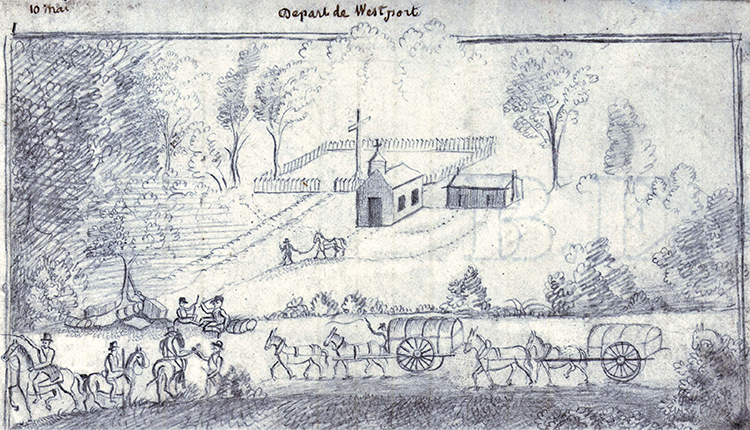
Sketch of the St. Francis Regis Church, rectory, and cemetery by Father Nicolas Point, 1841. COURTESY OF MANUSCRIPTS, ARCHIVES, AND SPECIAL COLLECTIONS DEPT., WASHINGTON STATE UNIVERSITY LIBRARIES
As the parish grew, it required a larger place of worship. Father Donnelly raised funds and oversaw the construction of a permanent brick church at the corner of 11th and Broadway streets. The Church of the Immaculate Conception — later designated Cathedral of the Immaculate Conception — was completed in 1857.
A New Catholic Cemetery
As the Catholic population grew, and city expansion began to encroach on the old St. Francis Regis burial site, Father Donnelly saw the need for a new Catholic cemetery. In 1873, he purchased 40 acres of hillside on the eastern outskirts of town. Mount St. Mary’s was dedicated four years later, and more than 1,400 graves were moved there.
Father Bernard Donnelly, ca. 1870. FROM THE LIFE OF FATHER BERNARD DONNELLY (1921)
Donnelly was buried at Mount St. Mary’s in 1880. His remains were moved to the Cathedral of the Immaculate Conception three years later but were interred at Mount St Mary’s again in 1927. Kansas City’s first bishops, John J. Hogan and Thomas F. Lillis, and other Diocesan leaders, were also laid to rest there.
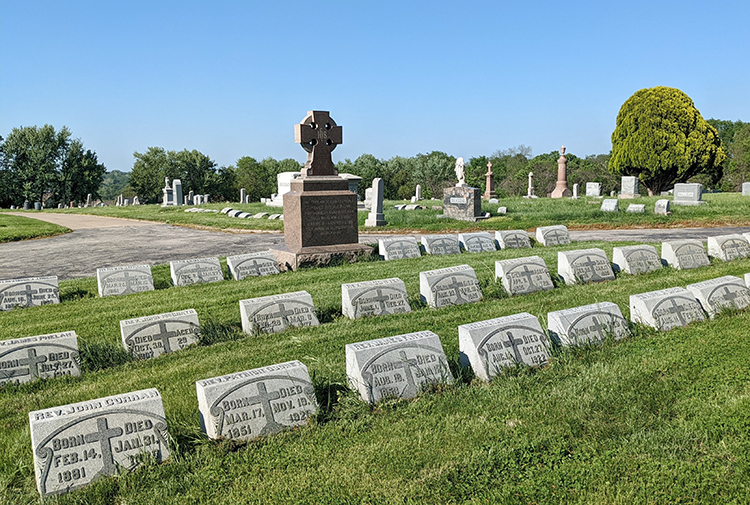
Priest’s Circle at Mount St. Mary’s Cemetery. JEREMY DROUIN
Jarboe, Troost and other prominent names associated with Kansas City’s early history are among the deceased at Mount St. Mary’s — as is one of the city’s oldest known residents, a French trapper named Jacques “Pino” Fournais who was purported to be 124 years of age when he in died in 1871. At the time of his funeral, Father Donnelly commented that “Old Pino” looked the same as he did when they first met more than three decades prior.
More notorious figures buried at the cemetery include organized crime kingpins Johnny Lazia and Nicholas Civella.
Over the decades, the church improved the grounds by adding stone portals and wrought iron gates in 1947 and more plots. The cemetery’s footprint eventually expanded to include its current boundaries, extending from 20th to 23rd Streets, and Cleveland Avenue to Jackson Avenue.
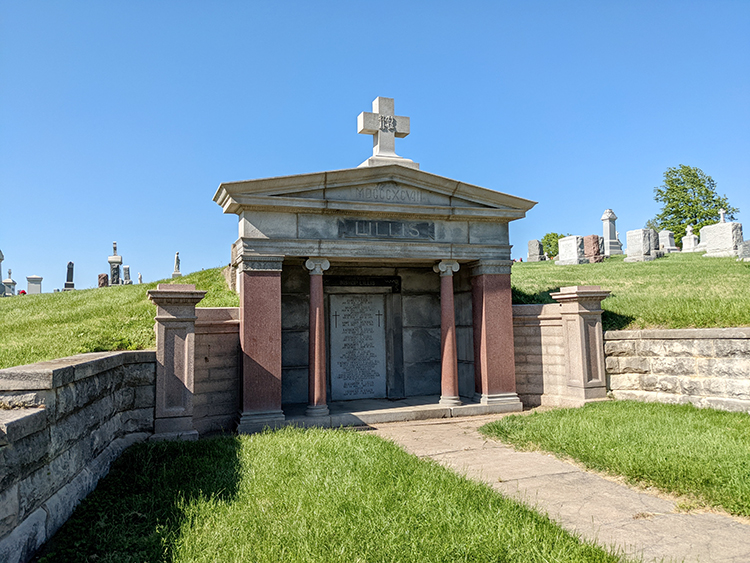
Lillis family tomb at Mount St. Mary’s Cemetery, the resting place of Bishop Thomas Lillis. JEREMY DROUIN

Pendergast family monument and headstones. Burial place of James Pendergast, city politician and older brother of Boss Tom Pendergast. JEREMY DROUIN
Honoring the Dead
It is not clear when Cemetery Day services were first held at Mount St. Mary’s. A Kansas City Times article from October 3, 1938, confirmed that a ceremony took place there the previous day, the 2, not on October 8, as is labeled on the Walsh family’s home movie.
The Times reported that more than 1,000 Catholics attended the memorial service to pray for the faithful departed. Bishop Lillis presided and Reverend George W. King of the Cathedral conducted the service. A similar observance was held earlier that day at Calvary Cemetery.
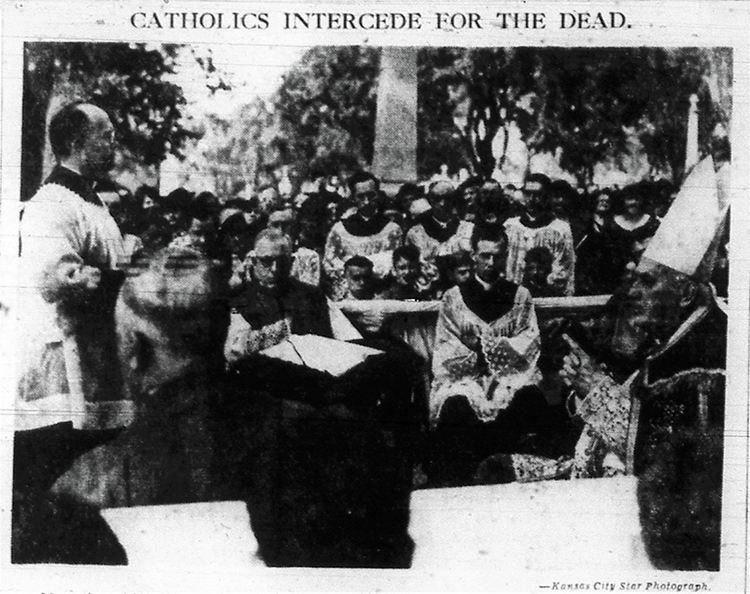
Cemetery Day service on October 3, 1938, at Mount St. Mary’s. THE KANSAS CITY TIMES
Cemetery Day was not a city-wide day of remembrance. Only the services at Mount St. Mary’s and Calvary cemeteries were reported.
While The Times article referred to Cemetery Day as an annual event, there are few mentions of it in newspaper records. A blurb in the October 30, 1943, Kansas City Star announced a Cemetery Day service taking place the next afternoon, on Halloween Day, at both Calvary and Mount St. Mary’s cemeteries.
Archived editions of The Catholic Register from the 1930s, housed in the Catholic Diocese of Kansas City-St. Joseph Archives, also reported on Cemetery Day services for the dead. They took place at Mount St. Mary’s on a Sunday in October and consisted of a procession of clergy, prayers and a sermon.
Memorial day at Kansas City Cemeteries
Memorial Day services at the cemetery were also major events. More than 5,000 Catholics attended a May 30, 1935, Mass to honor departed veterans. Congregants prayed the rosary, knelt to the pontifical blessing of Bishop Lillis and heard a sermon by Reverend James Foster of Holy Name Church. The Star reported that the service was accompanied by a children’s choir and a Boy Scouts guard of honor.
Memorial Day masses at local Diocesan cemeteries and wreath-laying ceremonies to honor veterans and first responders remain a tradition to this day.
In more recent decades, the first Sunday in November, following All Saints’ Day on November 1 and All Souls’ Day on the 2, has been celebrated as Cemetery Sunday. Established by the National Cemetery Conference in 1978, it is a day for Catholic families to honor loved ones who have passed by visiting gravesites and attending a special Mass at the cemetery.
It is plausible that annual Cemetery Day services at Mount St. Mary’s fell out of favor after Cemetery Sunday was established as an official Catholic observance. Or perhaps there is more to the story?
KCQ would like to hear from the Catholic community. Do you have memories of attending Cemetery Day at Mount St. Mary’s or other Catholic cemeteries? Did the services always take place in October? And when did they cease? You can reach us at KCQ@KCStar.com.
SUBMIT A QUESTION
Do you want to ask a question for a future voting round? Kansas City Star reporters and Kansas City Public Library researchers will investigate the question and explain how we got the answer. Enter it below to get started.

